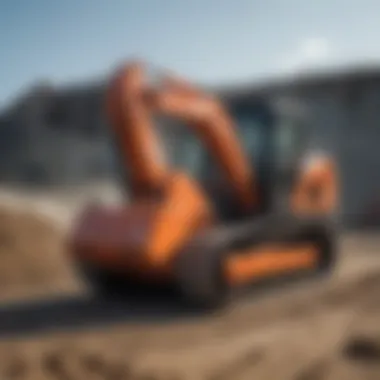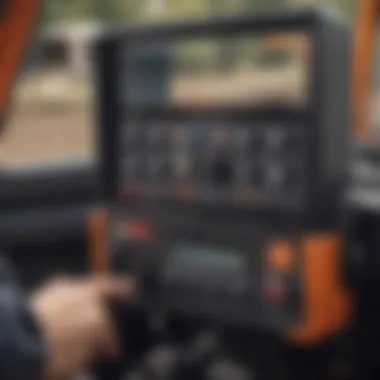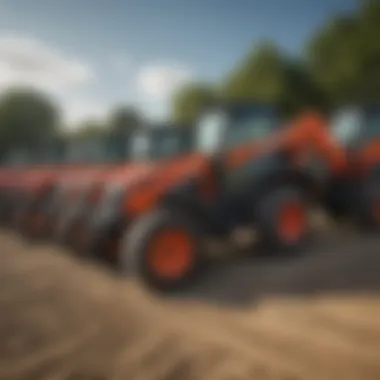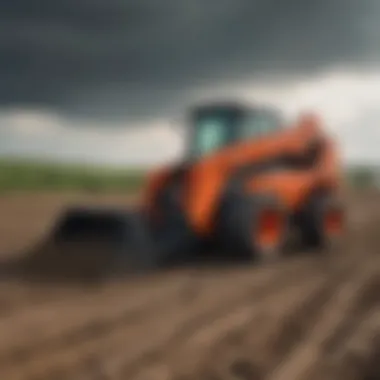Understanding the Cost of New Kubota Skid Steers


Intro
In the landscape of modern agriculture, choosing the right machinery is a critical decision for productivity and efficiency. Kubota skid steers have emerged as a popular choice among farmers and industry professionals due to their versatility and durability. The cost of acquiring new skid steers is often influenced by numerous factors, making it essential to understand the underlying elements before making a purchase. This article explores various aspects of getting a new Kubota skid steer, including pricing trends, financing options, and market comparisons. By delving into these topics, we aim to equip enthusiasts and professionals with the knowledge necessary to enhance their operations and make informed investments.
Research and Data Analysis
Understanding the pricing for new Kubota skid steers begins with research and data analysis. Agriculture trends and consumer demands impact the overall cost. Current trends show a significant interest in compact machinery that combines power with reduced foot-print for ease of use in limited zones such as farms or smaller landscapes.
Latest Trends in Agriculture and Horticulture
The agricultural sector is adapting to new technologies and changing environmental conditions. Innovative machinery, like Kubota skid steers, is gaining traction due to their ability to perform multiple tasks. Farmers increasingly need machines that not only assist in crop management but also fit various applications, like landscaping and transporting materials. Recent market observations suggest that features such as fuel efficiency, operational comfort, and ease of maintenance are now influential in purchasing decisions.
Statistical Insights into Crop Yields
Recent statistics reveal that effective machinery can directly influence crop yields. Skid steers, when utilized correctly, provide support in tasks like land preparation and soil compaction, which in turn affect the productivity of farmers. Detailed analyses have shown that integrating skid steers into agricultural practices can lead to a marked increase in harvest efficiency, with some reports indicating yield improvements of up to 20% in specific contexts.
"Investing in appropriate machinery is not just a matter of cost; it's a matter of maximizing output and enhancing the viability of agricultural practices."
Factors Influencing the Cost of Kubota Skid Steers
Price fluctuations of new Kubota skid steers can be attributed to various factors:
- Model Variations: Different models come with distinct features and horsepower, affecting the price.
- Attachments and Accessories: Additional tools can enhance functionality but also elevate costs.
- Market Demand: Seasonal trends can influence pricing due to supply and demand dynamics.
- Financing Options: Diverse financing plans can ease the financial burden, impacting perceived affordability.
Preface to Kubota Skid Steers
Understanding Kubota skid steers is essential for any professional in the agricultural sector. These machines have become vital tools that enhance productivity and efficiency on farms and construction sites. As farmers and industry experts consider investing in these machines, it is crucial to weigh their features and costs. Kubota offers a reputation for reliability and performance, which adds value to their skid steers. Knowing the details surrounding these machines can guide buyers in making informed decisions.
Overview of Kubota as a Brand
Kubota has established itself as a trusted name in agricultural machinery. Founded in Japan, the brand emphasizes quality and durability. Its machines are designed to handle tough conditions, making them appealing to farmers needing dependable equipment. Kubota's commitment to innovation also plays a key role in maintaining its leading position in the market. Over the years, the brand has expanded its product range to include not just tractors but also various types of construction equipment like skid steers.
Popular Models in the Market
Kubota skid steers are categorized into three main types: compact, mid-size, and heavy-duty models. Each type suits different work requirements and offers unique features that make them valuable for specific tasks. Below, we explore the specific aspects of each model category.
Compact Models
Compact models of Kubota skid steers are known for their small footprint and superior maneuverability. They are ideal for landscaping, urban construction, and other tasks where access is limited. A key characteristic of these models is their ability to work efficiently in tight spaces. This makes them a popular choice for contractors who often face space constraints.
One unique feature of compact models is their low ground pressure, which helps minimize soil disturbance. However, while their size is advantageous, it may also limit their lifting capacity compared to larger models.
Mid-Size Models
Mid-size models strike a balance between capacity and maneuverability. These machines are suitable for a broader range of applications, including agricultural tasks, landscaping, and light construction work. The primary advantage of mid-size models is their increased lift capacity without sacrificing too much in terms of size.
A notable feature is their versatility in attachments, enabling users to customize their machines for specific jobs. However, the trade-off can be in increased weight, which may not always be suitable for softer ground conditions.
Heavy-Duty Models
Heavy-duty models are engineered for handling the toughest tasks. They have robust build quality and higher lifting capacities, making them suitable for larger construction and farming projects. The main characteristic of heavy-duty models is their power and stability, enabling them to operate even in demanding environments.
These models often come equipped with advanced hydraulic systems, allowing for efficient operation. However, their size and weight can make them less agile in tight spaces, which is something buyers should consider when evaluating their options.
The distinctions between these models highlight the importance of understanding individual needs when selecting a Kubota skid steer. With this knowledge, potential buyers can better navigate the costs and benefits relevant to their agricultural or construction activities.


Factors Influencing the Cost of Kubota Skid Steers
Understanding the factors influencing the cost of Kubota skid steers is essential for those interested in machinery investment. This section delves into various elements that affect pricing, providing valuable insights for potential buyers. By recognizing these influences, buyers can make better purchasing decisions that align with their operational needs and budget constraints.
Model Specifications
Model specifications play a significant role in determining the price of a Kubota skid steer. Customers must consider three main aspects: engine performance, lift capacity, and attachment options.
Engine Performance
The engine performance is crucial in defining the skid steer’s functionality and suitability for specific tasks. A powerful engine not only increases productivity but also ensures efficiency during operation. Kubota models include advanced engines designed for various needs, offering high torque and flow rates. This makes them particularly beneficial for heavy-duty tasks. Moreover, many of these engines meet emissions standards, which is an essential consideration today. A high-performance engine can sometimes lead to increased initial costs, but the return on investment can be significant due to enhanced productivity and operation reliability.
Lift Capacity
Lift capacity refers to the amount of weight a skid steer can safely lift and carry. This factor can impact pricing directly. High lift capacities are advantageous for industries needing to move heavy loads regularly, such as construction or agriculture. Kubota skid steers are known for their robust lift capacities, which make them versatile tools on job sites. Higher capacities typically come with a higher price tag, reflecting the added engineering and materials involved. Thus, understanding your needs when it comes to lift capacity is vital for making an informed decision.
Attachment Options
Attachment options enhance the skid steer’s versatility, catering to a wide range of applications. Kubota skid steers can accommodate various attachments like buckets, forks, mulchers, and augers. The ability to switch attachments allows operators to tackle distinct tasks efficiently, increasing overall productivity. However, incorporating multiple attachments can elevate the initial investment. Choosing a model that supports the desired attachments and fits within budget can maximize operational effectiveness in the long run.
Market Demand and Supply
Market demand and supply dynamics significantly impact the cost of Kubota skid steers. If demand outpaces supply, prices tend to rise. Conversely, an oversupply with limited demand can drive prices down. Understanding these market conditions is essential for buyers to gauge the right time to purchase.
Regional Price Variations
Prices can vary by region due to factors like local demand, economic conditions, and varying competition levels.
Urban vs Rural Pricing
Urban areas often see higher prices for equipment due to increased competition among dealers and greater demand for reliable machinery. In contrast, rural areas might offer lower prices but with fewer options available. Buyers should evaluate these differences relevant to their location to understand potential costs fully.
Geographic Influences
Geographic influences can also dictate pricing strategies. Areas with higher labor costs tend to have machines priced higher. Meanwhile, regions more reliant on agriculture might see more competitive pricing for Kubota skid steers due to greater demand. Recognizing these geographic nuances can help prospective buyers navigate the marketplace more effectively.
"Understanding the factors that influence prices ensures that buyers make well-informed decisions when selecting Kubota skid steers that fit their needs and budget."
By examining model specifications, market demand, and regional variations, one can appreciate the nuanced landscape of Kubota skid steer pricing.
Financing Options for Kubota Skid Steers
When considering the acquisition of new Kubota skid steers, financing options are a critical component. A high-quality piece of machinery often comes with a significant cost. Understanding the available financing avenues can help buyers manage expenses effectively while ensuring they select a model that fits their operational needs. By exploring loans, manufacturer programs, and any applicable government incentives, buyers can make informed decisions that align with their financial strategies and operational goals.
Loans and Leases
Loans and leases are frequently utilized methods to finance a new skid steer. A loan typically involves borrowing a specified amount from a bank or lending institution, which the buyer repays over time with interest. This option allows buyers to own the equipment outright after completing the payment terms. On the other hand, leasing a skid steer offers a different approach. Through a lease, users pay to use the equipment for a predetermined time, often with an option to buy at the end of the term.
Considerations include:
- Monthly payment amounts: Loans might have lower initial payments but could lead to higher long-term costs due to interest rates.
- Ownership vs. usage: Decide if permanent ownership is essential or if temporary use suffices for your operation.
- Mileage and usage limits: Leases may impose usage limits, which could affect how and when the skid steer is employed.
While loans might suit long-term financial planning, leasing can offer flexibility and less upfront financial burden, especially for seasonal or short-term projects.
Manufacturer Financing Programs


Kubota offers its own financing solutions tailored to assist customers in acquiring equipment with competitive terms. These manufacturer financing programs typically include favorable interest rates, flexible payment plans, and sometimes promotional offers such as deferred payments or cash rebates.
Key points to consider:
- Promotional rates: Manufacturers occasionally run special offers, making new equipment more affordable.
- Streamlined application process: Financing through Kubota can often involve a quicker and easier application process compared to traditional loans.
- Loyalty programs: Long-term customers may benefit from additional discounts or advantages based on their purchasing history.
Utilizing manufacturer financing can lend peace of mind, knowing that your equipment has the backing of the manufacturer during ownership.
Government Subsidies and Incentives
Many regions offer government subsidies or incentives aimed at supporting agricultural growth and efficiency. For those looking to buy new Kubota skid steers, these programs can significantly offset costs. Subsidies may come in the form of grants or reduced interest loans, while incentives could include tax reductions or credits related to equipment purchases.
Factors worth considering include:
- Eligibility requirements: Check specific criteria to qualify for available programs.
- Application process: Understand what documents or certifications are needed to pursue subsidies or incentives.
- State or local differences: Various regions have unique programs that may benefit buyers, depending on local economic strategies.
These financial assistance options can make the difference in affordability, enhancing the opportunity for farmers and operators to invest in high-quality machinery that improves productivity.
Always assess each financing option’s terms to determine the most beneficial for your operations. Making a misstep here can affect your cash flow and overall profitability in the long run.
Cost Comparison with Competitors
Comparing the cost of Kubota skid steers with competitors is pivotal for buyers looking to maximize their investment in machinery. Understanding these comparisons provides insights into features, performance, and overall value. Evaluating costs can also help determine which models deliver better reliability or efficiency tailored to specific needs in agricultural sectors.
Kubota vs Other Leading Brands
Case Comparison
In a case comparison, the distinct features of Kubota skid steers are critically analyzed alongside similar models from brands like Bobcat and Caterpillar. The case comparison highlights Kubota's reputation for robust construction and reliable engine performance. Users often prefer Kubota for its easy maintenance and fuel efficiency, which are vital for long working hours in the field.
One unique aspect of case comparison is the attachment versatility offered by Kubota skid steers. They can accommodate a wide range of attachments, which enhances their functionality across different tasks. However, some users might find that certain competitor models offer higher-capacity attachments, making them more suitable for specific heavy-duty operations.
Advantages and Disadvantages
Evaluating the advantages and disadvantages of Kubota skid steers versus competitors reveals key insights. Kubota’s primary advantages include lower operational costs and excellent resale value. Many users find that their initial investment in Kubota machinery pays off in reduced repairs and maintenance over time.
On the downside, limitations in lift capacity when compared to some alternatives may sway buyers who prioritize heavy lifting capabilities. Also, while Kubota has a solid build quality, some people feel that brands like JCB may offer superior drive experiences in certain models. This makes comparing these attributes essential for informed decision-making.
Benchmarking Against Used Equipment
Benchmarking new Kubota skid steers against used equipment also provides valuable perspective. New models boast advanced technology and warranties yet come at a higher price point. In contrast, used equipment offers lower up-front costs, but this may bring the risk of unforeseen repairs.
When considering used machines, potential buyers should assess factors like:
- Condition of the Equipment: Look for wear and tear or any signs of previous maintenance issues.
- Historical Performance: Check the machine's history to understand its past use and upkeep.
- Market Value: Establish current pricing trends to judge whether the used equipment is priced fairly.
"Assessing both new and used options allows you to make balanced financial decisions and choose the right skid steer for your needs."
This critical analysis aids agricultural professionals to align their operational needs with budgetary constraints. By meticulously comparing costs, performance, and features, you can equip yourself with the right skid steer to enhance productivity and efficiency.
Long-Term Cost Considerations
Long-term cost considerations are vital when assessing the acquisition of new Kubota skid steers. While the initial purchase price is significant, understanding ongoing expenses can lead to more informed purchasing decisions. Farmers and industry professionals should evaluate long-term costs to gauge the overall financial impact of their investment. This analysis includes maintenance, fuel efficiency, and resale value, which all play a crucial role in the total cost of ownership.
Maintenance and Repair Costs


Regular maintenance and repair costs represent one of the key ongoing expenses associated with Kubota skid steers. Proper maintenance helps to ensure the machinery operates efficiently, enhancing both productivity and longevity. These costs can include routine services such as oil changes, filter replacements, and inspections. Additionally, unexpected repairs due to wear and tear can arise, making it essential to budget for these expenses. Understanding the specific maintenance requirements of models is beneficial. For instance, more complex models might need specialized care, potentially leading to higher costs over time. Keeping detailed records of all maintenance can aid in identifying patterns that may necessitate further investments.
Fuel Efficiency and Operating Costs
Fuel efficiency is a more variable expense often overlooked in cost considerations. Efficient fuel consumption reduces operational costs significantly, particularly for skid steers that are used regularly. Kubota models with advanced engine technology often showcase better fuel economy compared to competitors. Investing in a model with superior fuel efficiency might lead to substantial savings in the long run, especially if the skid steer is in daily use. It is also essential to consider the type of fuel used, as this might affect overall operating costs. Using premium fuels may enhance performance but could also increase daily expenditures. Calculating the average fuel consumption based on workload will lead to a more accurate understanding of operating costs.
Resale Value and Depreciation
The resale value of Kubota skid steers is another critical aspect of long-term cost considerations. Depreciation affects all equipment, yet Kubota's reputation for quality often means their machines retain value better than some competitors. Monitoring the market trends in used equipment can provide insights into potential resale values. Evaluating the depreciation rate of a specific model allows potential buyers to project its future worth accurately. Consideration should also be given to factors that enhance resale opportunities. Models equipped with desirable features or in excellent condition are likely to fetch a higher price on the used market.
Understanding these long-term considerations is essential for making wise purchasing decisions. Assessing maintenance, fuel efficiency, and resale can give a clearer picture of total cost over time.
In summary, when investing in Kubota skid steers, it is not only the purchase price that should be front of mind. It’s equally important to assess long-term costs to avoid financial surprises down the road. Making informed decisions today ensures a potentially profitable return on investment in the future.
Making an Informed Decision
When considering the purchase of a new Kubota skid steer, making an informed decision is a pivotal step. The financial investment involved is significant. It is essential not only to understand the upfront cost but also the long-term implications of owning and operating the machinery. Decision-making should be guided by a clear understanding of personal or business needs, thorough evaluation of costs, and identification of trusted dealers.
Assessing Your Needs
Before making any purchase, assessing your needs becomes crucial. Every operator has different requirements based on their specific operations.
- Understand Usage: First, consider how often you will use the skid steer. Frequent use may warrant buying a new model, while infrequent use could make renting a more economical option.
- Identify Tasks: Define the primary tasks for the skid steer. Will it be used for lifting, digging, or moving materials? Knowing the job specifications helps in selecting a model that has the right size and capabilities.
- Work Environment: Analyze the environments where you will operate. Are the areas large and open, or do you need a compact model for limited spaces?
By carefully assessing your needs, you can narrow down your options and choose a model that aligns with your operational requirements.
Evaluating Total Cost of Ownership
Total cost of ownership goes beyond the initial purchase price. It encompasses all expenses over the lifespan of the skid steer, providing a clearer picture of the financial commitment involved.
- Maintenance and Repairs: Consider routine maintenance costs and potential repairs. Kubota machines typically have lower maintenance costs due to their reliable build, but it’s wise to prepare for unexpected repairs.
- Operating Costs: Fuel efficiency impacts operating costs significantly. Look into how different models perform in terms of fuel consumption. A model that is more fuel-efficient can result in substantial savings over time.
- Depreciation: New skid steers lose value over time. Knowing the approximate resale value helps in understanding long-term costs. A model known for retaining its value can be a better investment in the long run.
Evaluating these factors ensures a comprehensive understanding of what owning a Kubota skid steer entails financially.
Identifying Reliable Dealers
Finding a trustworthy dealer is instrumental in making a successful purchase of a Kubota skid steer. A reliable dealer not only sells the machinery but can also provide valuable support post-purchase.
- Research: Begin by researching local dealers. Online reviews and customer testimonials can give insights into dealer reliability and service quality.
- Warranty and Support: Inquire about warranty options. A good dealer provides strong warranty support. This can save you from unforeseen costs if issues arise shortly after purchase.
- After-Sales Service: Assess the dealer’s commitment to customer service. Ongoing support, maintenance tips, and access to parts are essential for the long-term care of your skid steer.
Working with a reputable dealer ensures you have the necessary support for your equipment, enhancing the overall ownership experience.
Epilogue and Key Takeaways
The discussion about the cost of new Kubota skid steers culminates in understanding the overall financial implications of such an investment. This section provides a summary of key insights and preferences for making a prudent choice. The costs associated with these machines are multifaceted, requiring careful analysis beyond just the initial purchase price.
Summarizing Costs and Benefits
When considering the acquisition of a Kubota skid steer, weighing the total cost against the benefits is essential. The initial investment can be significant, but the potential returns can often justify the expense. Key costs include:
- Initial Purchase Price: Reflects the model and specifications chosen.
- Financing Options: Can provide leverage to acquire machinery without a huge cash outlay.
- Maintenance: Regular upkeep is vital to sustain performance over time.
- Operational Costs: Fuel consumption and other recurring expenses, which can fluctuate based on usage.
- Resale Value: Knowing the depreciation rate can help in long-term financial planning.
Benefits that offset these costs include increased productivity, versatility with attachments, and the reliability associated with Kubota's brand.
Future Trends in Skid Steer Pricing
Understanding future pricing trends for skid steers is crucial for buyers and industry stakeholders. Several factors are likely to impact the market in the coming years:
- Technological Advances: Innovations in machine features may lead to higher prices but could also enhance efficiency.
- Supply Chain Factors: Ongoing global supply chain challenges can affect availability and pricing.
- Market Demand: As more sectors adopt skid steers for diverse applications, demand fluctuations could influence prices.
- Economic Conditions: General economy trends, including recession or growth phases, might modify consumer spending behavior.
Anticipating these changes can aid potential buyers in making educated decisions. Staying informed about the market dynamics and trends can significantly impact the long-term success of machinery investments.















